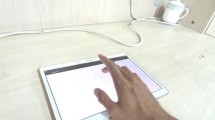Abstract
Traditionally, two approaches have been used to build intelligent room applications. Mouse-based control schemes allow developers to leverage a wealth of existing user-interaction libraries that respond to clicks and other events. However, systems built in this manner cannot distinguish among multiple users. To realize the potential of intelligent rooms to support multi-user interactions, a second approach is often used, whereby applications are custom-built for this purpose, which is costly to create and maintain. We introduce a new framework that supports building multi-user intelligent room applications in a much more general and portable way, using a combination of existing web technologies that we have extended to better enable simultaneous interactions among multiple users, plus speech recognition and voice synthesis technologies that support multi-modal interactions.
Access this chapter
Tax calculation will be finalised at checkout
Purchases are for personal use only
Similar content being viewed by others
Notes
- 1.
It is important to note that through this interface, additional types of input can be supported beyond the two presented here.
- 2.
The modification here is that all generated JavaScript events have the “isTrusted” flag set to true, which is usually only set to true for user generated actions. This allows us to interact with inputs, selects, etc. on a page that do not have an explicitly created “EventListener”.
- 3.
https://codepen.io/masterodin/pen/jOOPddy gives an example of this sort of content.
References
Bolt, R.: "Put-that-there": voice and gesture at the graphics interface. In: Proceedings of the 7th Annual Conference on Computer Graphics and Interactive Techniques, SIGGRAPH 1980, Seattle, Washington, USA, 1980, pp. 262–270. ACM, July 1980
Boring, S., Jurmu, M., Butz, A.: Scroll, tilt or move it: using mobile phones to continuously control pointers on large public displays. In: Proceedings of the 21st Annual Conference of the Australian Computer-Human Interaction Special Interest Group on Design: Open 24/7 - OZCHI 2009, Melbourne, Australia, p. 161. ACM Press (2009). https://doi.org/10.1145/1738826.1738853, http://portal.acm.org/citation.cfm?doid=1738826.1738853
Brooks, R.: The intelligent room project. In: Proceedings Second International Conference on Cognitive Technology Humanizing the Information Age, Aizu-Wakamatsu City, Japan, pp. 271–278. IEEE Computur Society (1997)
Carbini, S., Delphin-Poulat, L., Perron, L., Viallet, J.: From a Wizard of Oz experiment to a real time speech and gesture multimodal interface. Sig. Process. 86(12), 3559–3577 (2006)
Divekar, R.R., et al.: CIRA: an architecture for building configurable immersive smart-rooms. In: Arai, K., Kapoor, S., Bhatia, R. (eds.) IntelliSys 2018. AISC, vol. 869, pp. 76–95. Springer, Cham (2019). https://doi.org/10.1007/978-3-030-01057-7_7
Farrell, R.G., et al.: Symbiotic cognitive computing. AI Magazine 37(3), 81 (2016)
IBM: IBM Watson Cloud, May 2019. https://www.ibm.com/cloud/ai
Kephart, J.O., Dibia, V.C., Ellis, J., Srivastava, B., Talamadupula, K., Dholakia, M.: An embodied cognitive assistant for visualizing and analyzing exoplanet data. IEEE Internet Comput. 23(2), 31–39 (2019)
Krum, D., Omoteso, O., Ribarsky, W., Starner, T., Hodges, L.: Speech and gesture multimodal control of a whole earth 3D visualization environment. In: Proceedings of the Symposium on Data Visualization 2002, Barcelona, Spain, pp. 195–200. Eurographics Association (2002)
Langner, R., Kister, U., Dachselt, R.: Multiple coordinated views at large displays for multiple users: empirical findings on user behavior, movements, and distances. IEEE Trans. Visual. Comput. Graphics 25(1), 608–618 (2019). https://doi.org/10.1109/TVCG.2018.2865235. https://ieeexplore.ieee.org/document/8440846/
Noor, A.K., Aras, R.: Potential of multimodal and multiuser interaction with virtual holography. Adv. Eng. Softw. 81, 1–6 (2015)
Oviatt, S., Cohen, P.: Perceptual user interfaces: multimodal interfaces that process what comes naturally. Commun. ACM 43(3), 45–53 (2000)
Peveler, M., et al.: Translating the pen and paper brainstorming process into a cognitive and immersive system. In: Kurosu, M. (ed.) HCII 2019. LNCS, vol. 11567, pp. 366–376. Springer, Cham (2019). https://doi.org/10.1007/978-3-030-22643-5_28
Peveler, M., Kephart, J.O., Su, H.: Reagent: converting ordinary webpages into interactive software agents. In: Proceedings of the Twenty-Eighth International Joint Conference on Artificial Intelligence, International Joint Conferences on Artificial Intelligence Organization, Macao, China, pp. 6560–6562, August 2019. https://doi.org/10.24963/ijcai.2019/956, https://www.ijcai.org/proceedings/2019/956
Stallings, J.: RobotJS, October 2019. http://robotjs.io/
Tse, E., Greenberg, S., Shen, C., Forlines, C., Kodama, R.: Exploring true multi-user multimodal interaction over a digital table. In: Proceedings of the 7th ACM conference on Designing interactive systems - DIS 2008, Cape Town, South Africa. pp. 109–118. ACM Press (2008)
Zhang, Y.: Combining absolute and relative pointing for fast and accurate distant interaction. arXiv:1710.01778 [cs] October 2017
Zhao, R., Wang, K., Divekar, R., Rouhani, R., Su, H., Ji, Q.: An immersive system with multi-modal human-computer interaction. In: 13th IEEE International Conference on Automatic Face & Gesture Recognition (FG 2018), Xi’an, pp. 517–524. IEEE, May 2018
Author information
Authors and Affiliations
Corresponding author
Editor information
Editors and Affiliations
Rights and permissions
Copyright information
© 2020 Springer Nature Switzerland AG
About this paper
Cite this paper
Peveler, M., Kephart, J.O., Mou, X., Clement, G., Su, H. (2020). A Virtual Mouse Interface for Supporting Multi-user Interactions. In: Kurosu, M. (eds) Human-Computer Interaction. Multimodal and Natural Interaction. HCII 2020. Lecture Notes in Computer Science(), vol 12182. Springer, Cham. https://doi.org/10.1007/978-3-030-49062-1_33
Download citation
DOI: https://doi.org/10.1007/978-3-030-49062-1_33
Published:
Publisher Name: Springer, Cham
Print ISBN: 978-3-030-49061-4
Online ISBN: 978-3-030-49062-1
eBook Packages: Computer ScienceComputer Science (R0)




